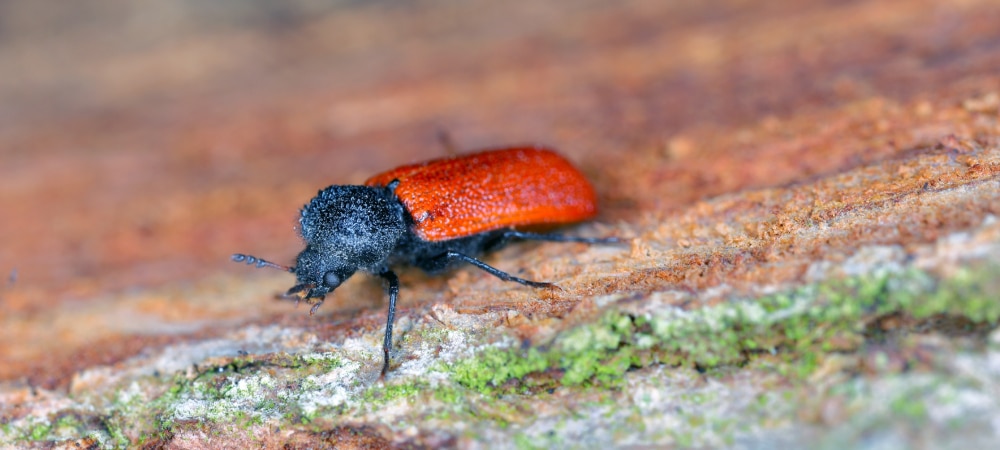
How to Tell the Difference Between Powderpost Beetles and False Powderpost Beetles
May 22, 2023
By Daniel Baldwin, BCE, CCFS, CP-FS
Powderpost and false powderpost beetles are common wood-boring pests that can cause extensive structural or cosmetic damage to the wood in and around your home. While they can often be confused for one another, these two wood-boring beetles cause different kinds and severities of wood damage and can require varied treatments to eliminate an infestation.
Use this guide to learn the difference between powderpost and false powderpost beetles and find out how to effectively remove them from your home.
Powderpost beetles vs. false powderpost beetles
While powderpost and false powderpost beetles may be less well-known than other wood-damaging pests (like termites), they can cause similar destruction to your home and cause a lot of costly repairs.
False powderpost beetles are somewhat less damaging to structural wood, while true powderpost beetles are capable of causing severe damage to floors, paneling, beams, and unfinished rooms and areas. Knowing which pest you have on your hands will help you determine the right course for removal.
What is a powderpost beetle?
Powderpost beetle is a term that actually refers to numerous species of wood-destroying beetles. This term encompasses these beetles because of their similar habits, size, and reproductive processes. The three groups that cause the most damages are lyctids, anobiids, and bostrichids.

Lyctid
Lyctid powderpost beetles are reddish-brown to black and range in size from 1/16 to ¼ inch long. They tend to need less moisture than other types of powderpost beetles. Lyctid beetle larvae typically begin emerging as adults from wood within a year.
Anobiid
Ranging from red to dark brown, anobiid powderpost beetles are typically 1/16 to ⅛ inch long. They are capable of attacking both hardwood and softwood. Their convex shape makes it easy for them to be confused with drugstore or cigarette beetles.
Bostricid
Bostricid powderpost beetles are reddish-brown to black and generally prefer hardwood to softwood, as they typically don’t attack the softwood framing within most homes. Their size varies depending on the species and ranges from a length of ⅛ to ¼ inch.
What is a false powderpost beetle?
A false powderpost beetle is a specific variation within the Brostricidae family. They are also referred to as augur beetles or horned powderpost beetles. False powderpost beetles are typically reddish-brown to black and range from ⅛ to 1 inch in size, with an elongated and cylindrical body.
False powderpost beetles are often confused with powderpost beetles because they cause similar-looking damage to wood. They prefer hardwood, but they will attack softwood. Infestations of false powderpost beetles are found in bark and firewood, grapevine wreaths, veneers, furniture parts, and ornamental products.

Are powderpost beetles harmful to humans?
Powderpost beetles and false powderpost beetles do not directly harm humans—just our homes. Powderpost beetles typically settle in the structural wood of your home while in their larvae state. They create tunnels through the wood as they consume it, leaving it weak and brittle. False powderpost beetles are likelier to attack small, decorated wooden items, especially if they still have the bark or natural edge intact.
Signs of a powderpost beetle or false powderpost beetle infestation
Powderpost beetles and false powderpost beetles can be challenging to spot because both are very small, and the larvae live within wooden structures. The clearest sign of a wood-boring beetle infestation is the exit holes you’ll find from the adults emerging from the wood. If the exit holes are the same color as the wood surrounding them, you’re likely looking at damage from an inactive infestation.
If you see fresh exit holes with darker wood around the exit and piles in or near the holes that look like fine sawdust, you’re likely dealing with an active infestation. The fine sawdust is called frass, the waste created from the powderpost beetle larvae eating the wood.
Pest control services
If you’re dealing with a potential powderpost or false powderpost beetle infestation, the best way to restore peace to your home is to hire a professional pest control service like Hawx Pest Control. With proven methods, qualified technicians, and the best products and services available, Hawx is the undisputed leader in pest control solutions. We use a three-fold process to address infestations thoroughly and create a custom treatment plan to suit your needs. Call us today for a free estimate to get your pest problem under control.
Categories
RELATED POSTS


